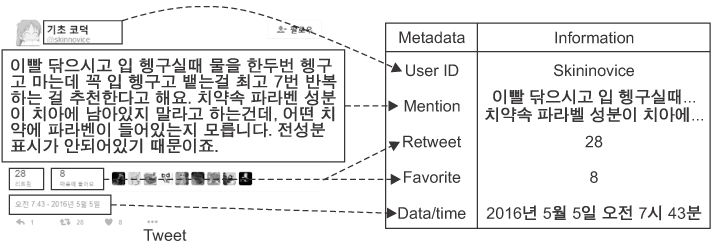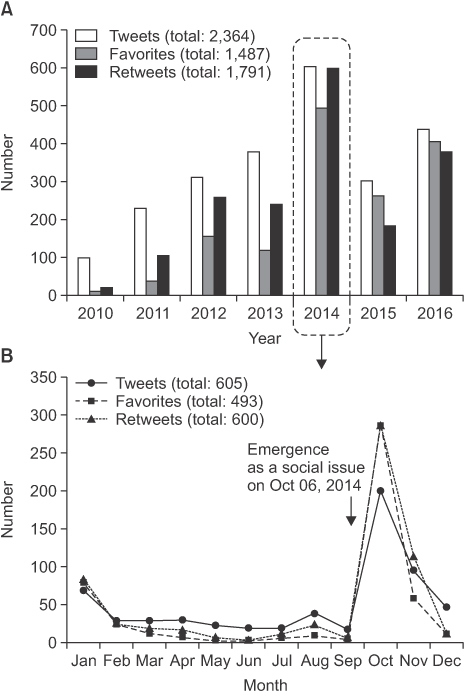J Korean Acad Oral Health.
2017 Jun;41(2):154-161. 10.11149/jkaoh.2017.41.2.154.
Changes in public recognition of parabens on twitter and the research status of parabens related to toothpaste
- Affiliations
-
- 1Graduate School of Archives and Records Management, Chonbuk National University, Jeonju, Korea.
- 2Department of Preventive Dentistry, School of Dentistry, Chonbuk National University, Jeonju, Korea. dentjjk@jbnu.ac.kr
- 3Institute of Medical Information Convergence Research in CBNU, Jeonju, Korea.
- KMID: 2389101
- DOI: http://doi.org/10.11149/jkaoh.2017.41.2.154
Abstract
OBJECTIVES
The purpose of this study was to investigate changes in public recognition of parabens on Twitter and the research status of parabens related to toothpaste.
METHODS
Tweet information between 2010 and October 2016 was collected by an automatic web crawler and examined according to tweet frequency, key words (2012-October 2016), and issue tweet detection analyses to reveal changes in public recognition of parabens on Twitter. To investigate the research status of parabens related to toothpaste, queries such as "paraben,""paraben and toxicity,""paraben and (toothpastes or dentifrices)," and "paraben and (toothpastes or dentifrices) and toxicity" were used.
RESULTS
The number of tweets concerning parabens sharply increased when parabens in toothpaste emerged as a social issue (October 2014), and decreased from 2015 onward. However, toothpaste and its related terms were continuously included in the core key words extracted from tweets from 2015. They were not included in key words before 2014, indicating that the emergence of parabens in toothpaste as a social issue plays an important role in public recognition of parabens in toothpaste. The issue tweet analysis also confirmed the change in public recognition of parabens in toothpaste. Despite the expansion of public recognition of parabens in toothpaste, there are only seven research articles on the topic in PubMed.
CONCLUSIONS
The general public clearly recognized parabens in toothpaste after emergence of parabens in toothpaste as a social issue. Nevertheless, the scientific information on parabens in toothpaste is very limited, suggesting that the efforts of dental scientists are required to expand scientific knowledge related to parabens in oral hygiene measures.
Keyword
Figure
Reference
-
1. Fischman SL, Yankell SL. Dentifrices, mouthrinses, and chewing gums. In : Harris NO, Garcia-Godoy F, editors. Primary preventive dentistry. 6th ed. New Jersey: Pearson Education Inc.;2004. p. 119–131.2. Castelain F, Castelain M. Parabens: a real hazard or a scare story. Eur J Dermatol. 2012; 22:723–727.
Article3. Park YD, Jang JH, Park JE, Kim JH, Kim EC, Song YJ, et al. Analysis of parabens in dentifrices and the oral cavity. Biomed Chromatogr. 2014; 28:1692–1700.
Article4. Błędzka D, Gromadzińska J, Wąsowicz W. Parabens. From environmental studies to human health. Environ Int. 2014; 67:27–42.
Article5. Jung HS. The evolution of Korean social network service focusing on the case of Kakao talk. J Digit Convergence. 2012; 10:147–154.6. Park JH, Rye PM, Oh HJ. A collecting model of public opinion on social disaster in twitter: A case study in ‘Humidifier Disinfectant’. KIPS Trans Softw Data Eng. 2017; 6:177–184.
Article7. Rastogi SC, Schouten A, de Kruijf N, Weijland JW. Contents of methyl-, ethyl-, propyl-,butyl- and benzylparaben in cosmetic products. Contact Dermatitis. 1995; 32:28–30.
Article8. Routledge EJ, Parker J, Odum J, Ashby J, Sumpter JP. Some alkyl hydroxy benzoate preservatives (parabens) are estrogenic. Toxicol Appl Pharmacol. 1998; 153:12–19.
Article9. Oishi S. Effects of butylparaben on the male reproductive system in rats. Toxicol Ind Health. 2001; 17:31–39.
Article10. Darbre PD, Aljarrah A, Miller WR, Coldham NG, Sauer MJ, Pope GS. Concentrations of parabens in human breast tumours. J Appl Toxicol. 2004; 24:5–13.
Article11. Johnson S. How Twitter will change the way we live. Time Mag. 2009; 173:23–32.12. Kwak HW, Lee CH, Park HS, Moon S. What is Twitter, a social network or a news media? In : Proceedings of the 19th international conference on World wide web; ACM;2010. p. 591–600.13. Marsh PD. Microbiological aspects of the chemical control of plaque and gingivitis. J Dent Res. 1992; 71:1431–1438.
Article
- Full Text Links
- Actions
-
Cited
- CITED
-
- Close
- Share
- Similar articles
-
- Toxicities of Four Parabens and Their Mixtures to Daphnia magna and Aliivibrio fischeri
- Food Additives and Allergic Diseases in Childhood
- Atopic Dermatitis and Food Additives in Childhood
- Gastrointestinal tract and skin permeability of chemicals in consumer products using parallel artificial membrane permeability assay (PAMPA)
- Sentiment and Topic Modeling Analysis on Twitter Reveals Concerns over Cannabis-Containing Food after Cannabis Legalization in Thailand





